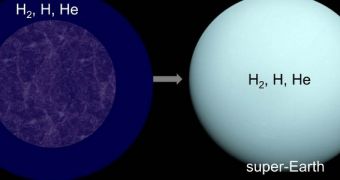Astronomers with the Space Research Institute (IWF) at the Austrian Academy of Sciences (OAW) have determined in a new study that not all super-Earths are hospitable for life, even if they orbit around their parent stars inside the habitable zone, where temperatures are just right to support the presence of liquid water.
The research team, led by investigator Dr. Helmut Lammer, says that only some super-Earth-class alien worlds – planets that are heavier than our own, but significantly less massive than gas giants such as Neptune or Uranus – are able to support life, and provides a series of arguments to support this idea.
Though all planets between 1 and 15 Earth masses are cataloged as super-Earths, a large amount of variability exists within this group. The team determined in its new study that only alien worlds that form around less massive cores can become truly Earth-like, in the sense that life becomes possible.
All exoplanets that form around more massive cores are likely to end up as Neptune and Uranus, the ice giants in our own solar system. These are worlds with a very dense atmosphere, meaning that they will remain sterile for all time, the Royal Astronomical Society reports.
Over the past 20 years, numerous worlds similar to our own have been detected by several missions, most notably the NASA Kepler space telescope. Though at first glance these planets look to be nearly identical to our own, first impressions can be deceiving, the team argues in the latest issue of the esteemed journal Monthly Notices of the Royal Astronomical Society.
For this study, the team developed a model on how hydrogen is captured and/or removed from planetary cores as exoplanets 0.1 to 5 times the mass of Earth form. Their conclusion was that worlds with Earth-like density, but less than 0.5 times its mass, will capture only little gas from the protoplanetary disks around freshly-formed stars.
For heavier planets, the amount of hydrogen they retain through sheer gravitational attraction is significantly larger, resulting in an atmospheric structure more similar to that of an ice giant. Astronomers most commonly classify these worlds as mini Neptunes.
“Our results suggest that worlds like these two super-Earths may have captured the equivalent of between 100 and 1000 times the hydrogen in the Earth’s oceans, but may only lose a few percent of it over their lifetime,” Lammer explains.
“With such thick atmospheres, the pressure on the surfaces will be huge, making it almost impossible for life to exist,” he adds. This investigation therefore suggests that the search for exoplanets that support life should focus on low- or average-density super-Earths, rather than on more massive objects.

 14 DAY TRIAL //
14 DAY TRIAL //